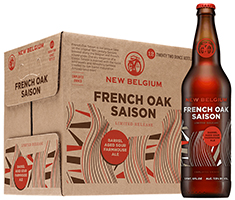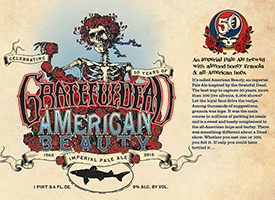 Every few years, health-conscious foodies go giddy over a new grain-or rather, an old one. Farro, teff, kamut, amaranth and that hippie potluck favorite, quinoa, have all had their day in the sun. The current candidate for stardom, at least in our eyes, is an ancient Middle Eastern grain known as spelt. Its scientific name is Triticum spelta, and its often-used German name is Dinkel. Mankind’s first known brewers, the Sumerians, almost certainly made beer from spelt. Spelt is the result of a cross between Emmer (Triticum dicoccum) and wild grasses in Mesopotamia some 10,000 years ago. Spelt doesn’t sound tasty. Not at all. Doesn’t even sound like food, let alone an ancient substance that lost out to wheat and barley in history’s great grain race. For the record, it’s high in fiber, low in fat, and surprisingly tasty. And if the very idea of spelt turns you off, Peaks and Pints sample flight of craft beers brewed with spelt is sure to bring you back. Used at proportions approaching 50 percent of the grist, spelt malt gives mild, nutty flavors backed by tangy acidic notes, which you’re sure to taste in our Craft Beer Crosscut 6.7.17: A Flight of Spelt.
Every few years, health-conscious foodies go giddy over a new grain-or rather, an old one. Farro, teff, kamut, amaranth and that hippie potluck favorite, quinoa, have all had their day in the sun. The current candidate for stardom, at least in our eyes, is an ancient Middle Eastern grain known as spelt. Its scientific name is Triticum spelta, and its often-used German name is Dinkel. Mankind’s first known brewers, the Sumerians, almost certainly made beer from spelt. Spelt is the result of a cross between Emmer (Triticum dicoccum) and wild grasses in Mesopotamia some 10,000 years ago. Spelt doesn’t sound tasty. Not at all. Doesn’t even sound like food, let alone an ancient substance that lost out to wheat and barley in history’s great grain race. For the record, it’s high in fiber, low in fat, and surprisingly tasty. And if the very idea of spelt turns you off, Peaks and Pints sample flight of craft beers brewed with spelt is sure to bring you back. Used at proportions approaching 50 percent of the grist, spelt malt gives mild, nutty flavors backed by tangy acidic notes, which you’re sure to taste in our Craft Beer Crosscut 6.7.17: A Flight of Spelt.
 The Commons Fleur de Blanc
The Commons Fleur de Blanc
5.8% ABV
Brewer Mike Wright, who launched The Commons Brewery in his Southeast Portland garage six years ago, does Belgian-style beer better than just about anyone in his hometown of Portland, Oregon. Wright homebrewed for a decade, but hadn’t considered a career in beer until he took second place at the 2010 Cheers to Belgian Beers festival in Portland. That beer was Urban Farmhouse, still made using the yeast strain required for every beer at that year’s festival. For kicks, Wright decided to undertake what he calls the “bureaucratic journey” of getting a brewery licensed in his garage. Today, he’s known for brewing well-executed, moderate alcohol beers with a refreshing and unique character. His Fleur de Blanc is a white farmhouse with rose hips, rose pedals and elder flowers. The addition of spelt provides a foundation for the delicate floral characters to build on. A wonderful warm-weather thirst quencher!
 New Belgium French Oak Saison
New Belgium French Oak Saison
7.5% ABV, 23 IBU
Consider Belgium. To the north, you have Flanders, a region known for everything from white beer to oak-aged sour brown ales. To the south, you have Wallonia, a region known for its rich farmland, industrial coalfields, French culture and farmhouse ales like Biere de Garde and saison. New Belgium’s French Oak Saison pulls inspiration from both regions by marrying a dry, hop-forward Wallonia-style saison with a golden ale soured in French oak foeders for 15 to 18 months — a method derived from Flanders. The rye and spelt grains in the saison contribute to a medium-light body while Huell Melon and Tettnang hops give aromas of honeydew and white pepper. The result is a rustic, goldenrod yellow saison offering pleasant lemon and white grape aromas and a bright, mouthwatering sourness with a clean, dry finish.
 Propolis Beltane
Propolis Beltane
7.5% ABV
Propolis Brewing beers sound as though they’re pulled from nomenclature in a botany field guide: Granum, Zephyros, Achillea, Wendas, Urtica, Beltane. That’s because Propolis is anything but your typical brewery. Their beers incorporate herbs and wild-foraged ingredients like spruce tips, berries, flowers, and other plants, crafted in the style of French and Belgian farmhouse ales, as well as Old World brewing styles that were common in beer-making’s infancy. Propolis’ Beltane is an elderflower saison brewed with spelt, Propolis House Microbes and Brettanomyces for two years. The 2104 Great American Beer Festival gold medal winner has a floral nose with a creamy body and a rustic honey tartness with bright floral highlights and a crisp, dry finish.
OK, we couldn’t complete our spelt craft beer flight with the beers currently on site. We’re winging it with the last two slots on our beer flight crosscut featuring Dogfish Head Crafted Brewed Ales beers with unusual ingredients.
 Dogfish Head Saison du Buff
Dogfish Head Saison du Buff
6.8% ABV
The fact that Dogfish Head, Victory and Stone each put out a version of Saison du Buff may seem confusing. Don’t be confused: The three breweries collaborated on the recipe — a saison with parsley, sage, rosemary and thyme; aka Simon and Garfunkel beer —then each brewed the beer independently. Dogfish Head‘s version pours with a hazy golden color and a thick, off-white head that dies down moderately and leaves light lacing. The aromas definitely give off hints of citrus, lemon zest, thyme, sage, light rosemary, bready malts and Belgian yeast. Like the aromas, it has citrus, lemon, a lot of sage, thyme, rosemary, a touch of parsley, herbal notes, a light breadiness and some Belgian yeast. You definitely get a lot more of the spices on the palate.
 Dogfish Head American Beauty
Dogfish Head American Beauty
9% ABV, 55 IBU
Dogfish Head called upon the Grateful Dead’s fans for input on American Beauty’s pale ale recipe, and after receiving what the brewery said were 1,500 suggestions, organic granola stood out as the top choice. Of course, granola may have won by default considering what ingredients immediately come to mind when you think of the Grateful Dead. At least, mercifully, spirulina and patchouli didn’t make the cut. The beer has a bready, almost oaty smell, and a bit reminiscent of hippie bread. Expect light malt sweetness on the tongue with a nutty hop bitterness, revealing caramely hints of apricot, honey and maybe even raisin. We also got a little cotton-mouthed — from the hops, of course.
